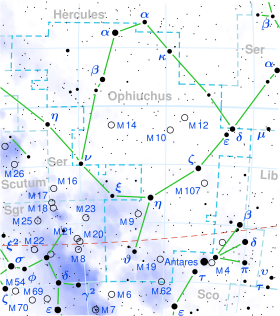| Observation data Epoch J2000 Equinox J2000 | |
|---|---|
| Constellation | Ophiuchus |
| Right ascension | 17h 26m 22.21749s [1] |
| Declination | −24° 10′ 31.1190″ [1] |
| Apparent magnitude (V) | 4.16 [2] |
| Characteristics | |
| Spectral type | kA5hA9mF1III [3] |
| U−B color index | +0.12 [4] |
| B−V color index | +0.28 [4] |
| Astrometry | |
| Radial velocity (Rv) | −37.20 [5] km/s |
| Proper motion (μ) | RA: +0.10 [1] mas/yr Dec.: −118.18 [1] mas/yr |
| Parallax (π) | 39.22±0.24 mas [1] |
| Distance | 83.2 ± 0.5 ly (25.5 ± 0.2 pc) |
| Absolute magnitude (MV) | 2.13 [2] |
| Details | |
| Mass | 1.77 [6] M☉ |
| Radius | 1.9 [7] R☉ |
| Luminosity | 13 [6] L☉ |
| Surface gravity (log g) | 4.15 [8] cgs |
| Temperature | 7,559 [8] K |
| Metallicity [Fe/H] | +0.30 [2] dex |
| Rotational velocity (v sin i) | 78 [6] km/s |
| Age | 1.028 [8] Gyr |
| Other designations | |
| b Oph, 44 Oph, CD−24°13337, FK5 1457, GC 23597, GJ 9591, HD 157792, HIP 85340, HR 6486, SAO 185401 [9] | |
| Database references | |
| SIMBAD | data |
44 Ophiuchi is a single [10] star in the constellation Ophiuchus. It has the Bayer designation b Ophiuchi, while 44 Ophiuchi is the Flamsteed designation. It is visible to the naked eye as a faint, white-hued star with an apparent visual magnitude of 4.16. [2] The distance to this object is approximately 83.2 light years based on parallax. [1] It is drifting closer to the Earth with a heliocentric radial velocity of -37.2 km/s, [5] and is predicted to come within 30 light-years around 585,000 years from now. [11]
This is an Am star with a stellar classification of kA5hA9mF1III, [3] indicating it has the luminosity class of a giant star with a spectrum that matches an A5 star based on the calcium K line, and an A9 star from the hydrogen and metal lines. It is around a billion years old [8] with 1.77 [6] times the mass of the Sun and 1.9 [7] times the Sun's girth. The star is radiating 13 [6] times the Sun's luminosity from its photosphere at an effective temperature of 7,559 K. [8] It retains a moderately high rotation rate, showing a projected rotational velocity of 78 km/s. [6]
